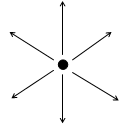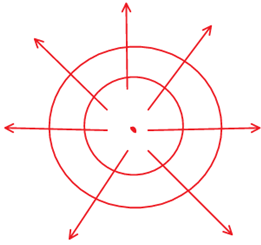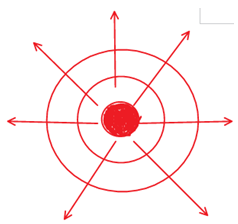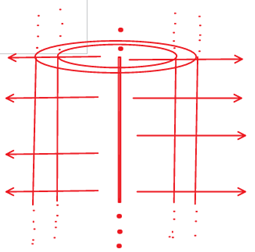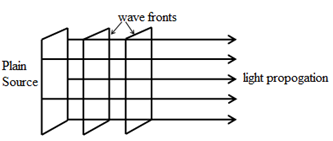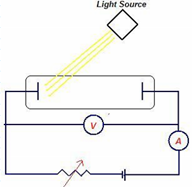11th And 12th > Physics
DUAL NATURE OF MATTER MCQs
:
B
As we have seen earlier, the intensity from a point source decreases as the square of the distance from the source. If intensity I1 was received at a distance r1, and I2 at r2 -
Iα1r2⇒ I1I2=r22r21=(2r1)2r21=4⇒ I2=14I1⇒ I2=0.25 I1
:
C
The work function is a characteristic of the metal surface - meaning, it does not depend on external factors, like temperature, external electric fields, etc. But in this example, since the electric field is already providing some energy to the electrons, won't the minimum energy needed to come out of the surface decrease now? Yes, true. Then where are we going wrong? Consider the following analogy.
I am really late for class and I am not even within the school. So I decide to climb the boundary wall closest to my class and make a run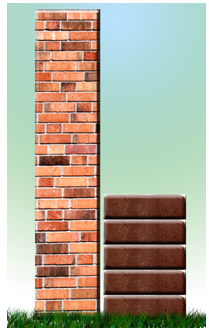 .
.
To my disappointment, I find the wall to be 3 meters tall, while I stand at 1.5 meters only, and weigh 50 kgs. Since my potential energy on top of the wall would be approximately 50×10×3J=1500 J(simple application of P.E = mgh), I would require 1500 J to get on top. I decide to pile a few bricks to a height of 1 meter and stand on top of the pile. Since I'm closer to the top, I will require only (50×10×2) J = 1000 J of energy to make it. Sure, it's easier for me to make the jump now, but - has the height of the wall changed because of the pile of bricks? NO. The wall is still 3 meters high. The pile of bricks is merely an aid (I still had to spend 500 J to get on top of the pile of bricks).
The work function is defined as the minimum energy an electron requires to overcome the binding potential in the absence of external help, like energy from a light source, external electric fields, thermal energy, etc. This is a characteristic feature of the metal surface and does not change, just like the 1500 J of energy required to climb the entire height of the wall in our analogy.
:
B
A point source radiates energy equally in all direction
Same is true for a spherical source. Assuming it radiates energy equally in all directions
An infinite line source will radiate energy perpendicular to its surface in all direction. So the wave front will be…
Yup......Right again.
Cylindrical.
Plane source.
Planar light source will have planar wave fronts.
So correct answer is infinite line source will have a cylindrical wave front.
:
B
By using λ=hmvrms⇒λ=6.6×10−342×1.67×10−27×3×103=0.66∘A
:
B
There are various ways to transfer the sufficient energy to free electrons in a metal and make them leave the surface.
(a) Thermionic emission: The metal surface is heated until the electrons gain sufficient energy to come out.
(b) Field emission: High electric field is applied across the metal to pull out the electrons
(c) Secondary emission: A high energy electron is made to hit the plate thereby transferring sufficient energy to other electrons to come out.
(d) Photo electric emission is another way in which light with sufficient energy is shone on a plate and the electrons absorb this energy to eject out of the metal surface.
:
B
In the diagram, light is falling on the left, which is the emitter plate, and the photoelectrons would be collected by the plate on the right, the collector plate. Electrons being negatively charged, will be repelled and slowed down if the collector plate is made negative. or if the emitter plate itself is made positive, electrons coming out will be attracted back to the left, and could, possibly, never make it to the collector plate - thus achieving stopping potential. Hence, (b) is correct.
:
C
λ∝1p⇒Δpp=−Δλλ⇒∣∣Δpp∣∣=∣∣Δλλ∣∣⇒p0p=0.25100=1400⇒p=400p0.
Note: The above method is applicable only when the changes in wavelength or momenta are small.
:
B
If momenta of the electron and photon are equal, their wavelenghths should also be equal.
λ=hmv⇒v=hmλ=6.6×10−349.1×10−31×5200×10−10⇒v=1.4×103m/s.
:
A
λ=hmv and E=12mv2⇒λ=hv2E when v and E both are doubled, λ remains unchanged i.e. λ′=λ.
:
A
12mV2=32kT
⇒mV=√3mKT
λ=hp=hmV=h√3mKT
⇒λ α=1√T
⇒λ1λ2=√T2T1=√273+927273+27=2
⇒λ2=λ12=λ2.

